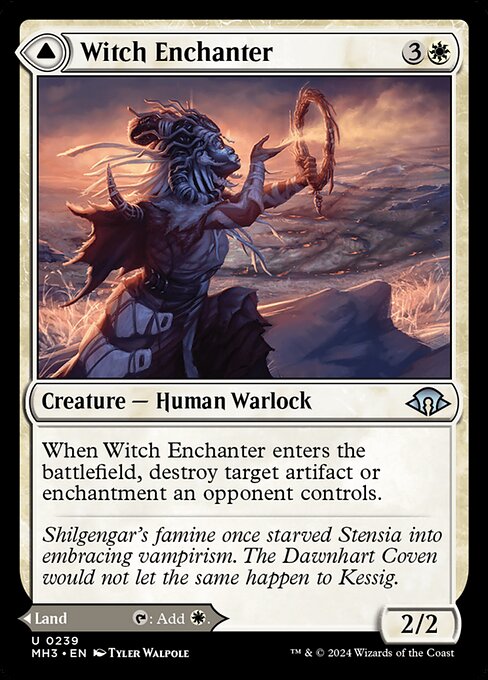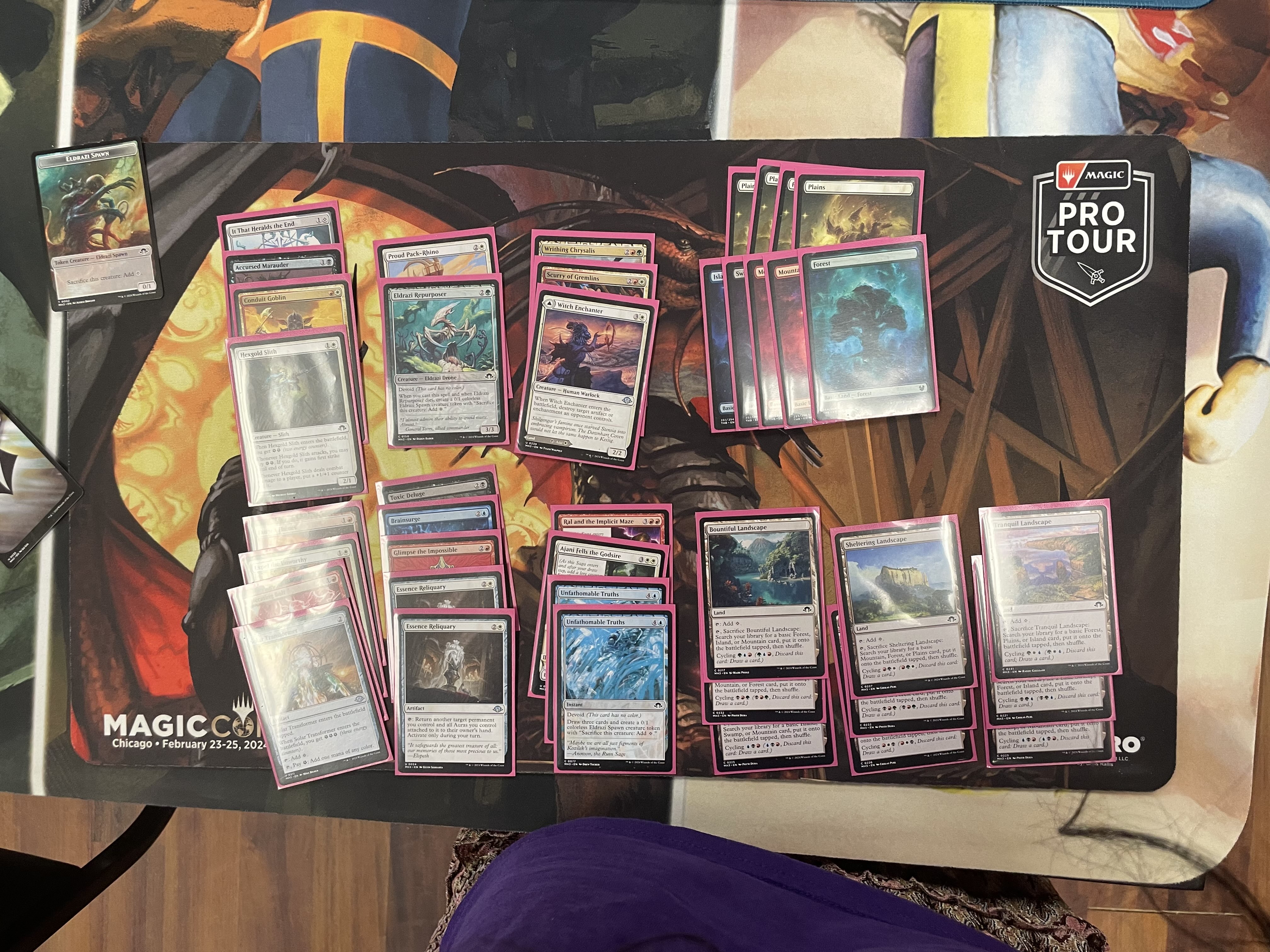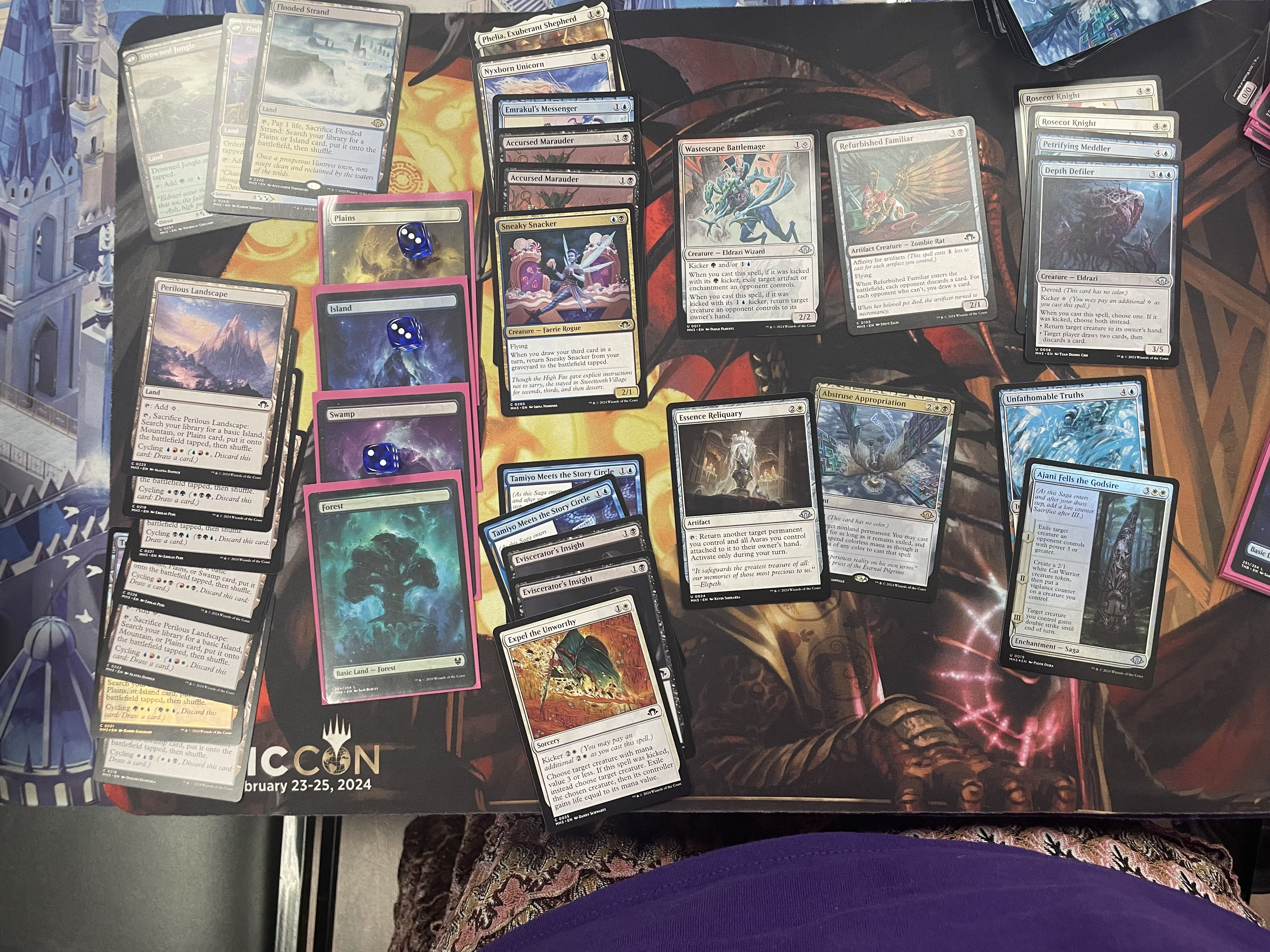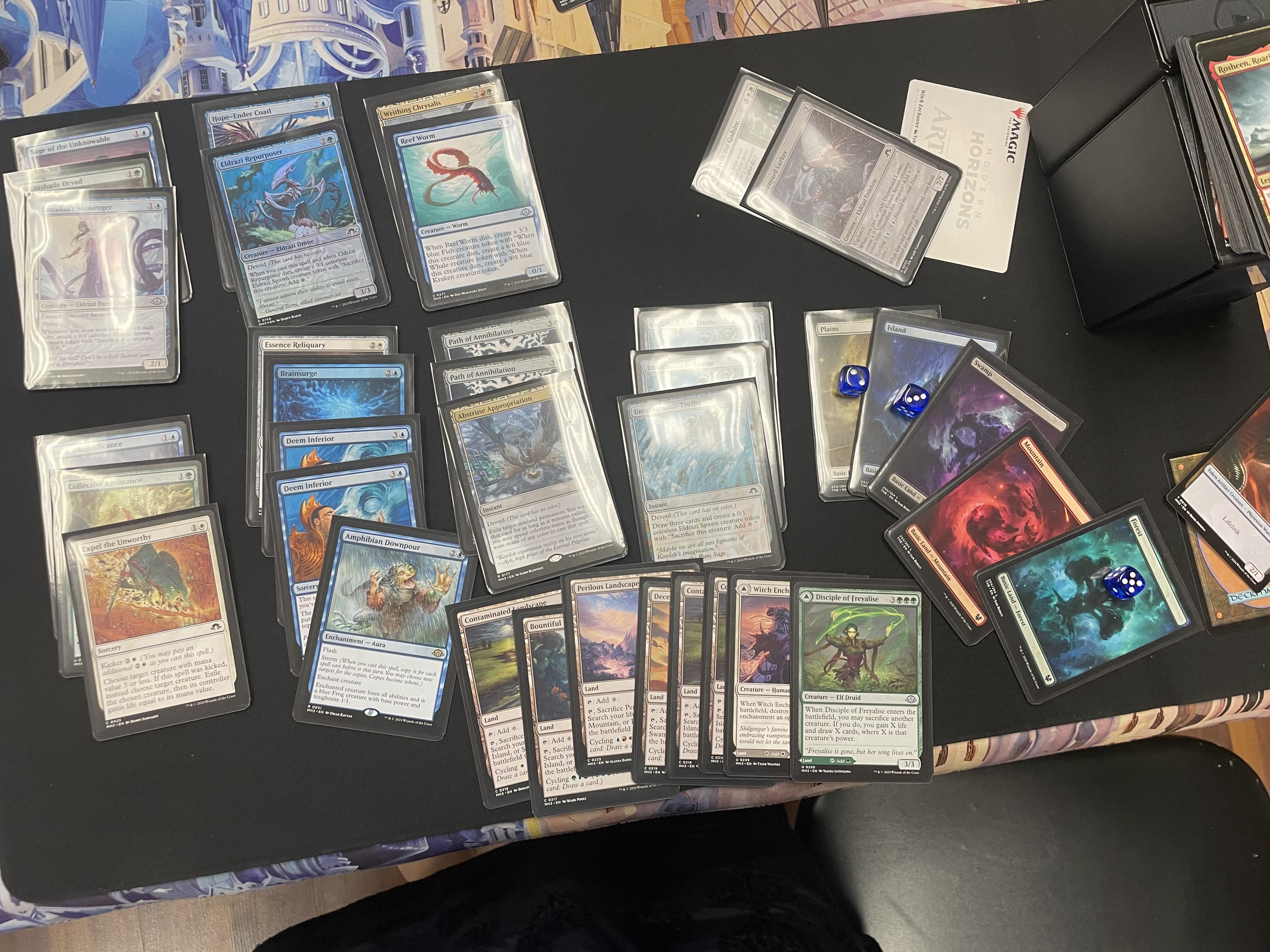The Essence of MH3 Draft
06/11/2024
Across this past week, I've drafted MH3 roughly 15 times: 2 Sanctum in-house drafts, ~6 early access drafts, and 7 paper drafts. It's quite a lot of drafts to have done already, and throughout them all I have been absolutely falling in love with this format.
It's the exact kind of format that caters to me specifically: an extremely high synergy format. There are many incentives to find a niche and really dig into it during each draft, building as focused of a deck as you can with cards that are specifically good in your deck rather than generically good in the format.
One of those incentives is where the power in the format lies: instead of having strong rate-monster cards like
Organ Hoarder that are good in any deck, a lot of the power in the set comes from contextual cards. Not only does MH3 have three fairly parasitic main mechanics in Eldrazi, Energy, and Modified; it also has quite a few strong individual buildarounds at uncommon and rare, such as Chthonian Nightmare and Essence Reliquary.So today, I figured I would write about one of the less obvious archetypes in the set, and one that I've been specifically enjoying quite a lot: Essence Reliquary.
Part 1: Using Reliquary

my favorite card right now
Essence Reliquary itself looks pretty simple - every turn, you can bounce one of your own permanents to hand. But there is actually quite a bit of depth in using it that you might not be aware of at first glance! So I figured I'd go over in detail all of the cool tricks you can do with the card:
The Basics
The default usage of Reliquary is, of course, to get tons of ETB and on-cast trigger value. Repeatedly bouncing and recasting your own permanents does of course cost a lot of mana, but it can represent a lot of value with the right tools. Anything that says "when this enters the battlefield" or "when you cast this spell" is pretty fair game to get value from - but there are a bunch of less obvious uses too.
Sagas

Sam Black would be proud
Sagas are pretty obviously nice with Reliquary - but what you might not realize is that you can actually get the last chapter of the saga as well before bouncing it! Reliquary can be activated at instant speed on your turn, so you can put the final chapter ability on the stack, and then bounce the saga in response - sagas don't go to the graveyard until their final chapter ability has finished resolving.
So, you can actually get the full value out of a saga before bouncing it with Reliquary. This can be very nice for deck-looping with
Tamiyo Meets the Story Circle :)Lands

this enchanter is pretty nice at disenchanting everything
First of all, Reliquary says "target permanent you control" - this means you can bounce lands. This has two main uses in this set:
First of all, you can bounce your MDFCs! In a Reliquary deck, I'm more willing to play MDFCs as lands first even if I think I'll want the spells later, since Reliquary will just give me access to them. This comes up quite a lot actually, especially since I draft MDFCs pretty highly - it can pretty cleanly represent drawing raw extra cards in the lategame.
The other land interaction is perhaps less obvious: you can tap a land for mana, bounce it to hand with Reliquary, and then replay it. This obviously doesn't generally accomplish much in terms of card advantage (barring the few landfall triggers), but it can actually help with various mana issues!
For example: if you don't have a different untapped land to play, this lets you get 1 more mana than you would've been able to otherwise. If you need two blue mana but only have one plains in play, this lets you do that. If you have no blue mana but a blue fetch in play, this lets you fetch for an island, bounce the island, and then replay it to get the blue mana.
Basically, a good way to think about this framing is that you can tap Reliquary and spend a land drop to untap any land (except taplands) - this can even work with something like
Nesting Grounds to let you double activate it.Instant-Speed Shenanigans

extremely significant interaction
Finally, there are quite a few instant-speed shenanigans you can pull off with Reliquary.
The most important ones are
Utter Insignificance and Accursed Marauder. Both are somewhat removal, and normally would remove themselves from play - but Reliquary can let you reuse them indefinitely!Marauder is a bit more restrictive here - it's only an edict, and for the reliquary combo to work you must have no other nontoken creatures. But if you do cast Marauder with a board of only tokens, then you can bounce it to hand with Reliquary in response to the trigger and sac nothing!
Utter Insignificance is more impressive, but also more mana intensive. The trick here is to activate the "exile enchanted creature" ability, and then activate Reliquary in response to bounce the Utter Insignificance. Since that ability doesn't require sacrificing Utter Insignificance or anything as a cost (the aura just normally falls off after the creature is exiled), you can just use this combo to exile one creature per turn for 5 mana (3CU).
There are also of course various tricks you can do in combat - Reliquary lets you attack with everything and save a thing that would've been eaten in combat, and also gives you a bit of protection from combat tricks on your turn to boot. These don't come up quite as often, as Reliquary decks aren't generally attacking that much - but they do matter!
Part 2: Building Reliquary Decks
Okay, now that we know all of the tricks to using Reliquary, how do we actually build these decks?
Well, I kind of like to think of Reliquary decks as having various categories of cards that they're looking for. Each category plays an important role, and the ideal deck has a good mix of all of these things. As such, an ideal Reliquary deck is pretty hard to actually pull of in draft - but we can still get most of the power from getting most of the way there.
These categories will be in a very rough "order of importance" - but this should not be taken as a pick order by any means.
Category 1: Reliquaries

a knight of the reliquary, so to speak
Essence Reliquary is, of course, very important to these decks. It's a very specific niche for a very specific card, and that card is an uncommon - so it can be hard to speculate on this deck before you have any copies. There also aren't any replacements that come close to doing this same thing; you could give
Distinguished Conjurer a glance, but it just doesn't do nearly enough of the things that Reliquary does.In this category are also cards that can find Essence Reliquary, as the difference between having one and not having one can be huge. You ideally don't want to lose games just because your one Essence Reliquary is in the bottom 5 cards of your deck.
Rosecot Knight is pretty nice for this, as it also finds a lot of the good Reliquary value targets (sagas and Utter Insignificance), while being a Reliquary value target itself. Raw card draw like Brainsurge and Unfathomable Truths also excel, as you generally want to hit your land drops as a deck looking to go very long. Cheap cantrips like Malevolent Rumble can also do the trick.
Category 2: Defensive Speed

probably not actually this one, but you get the gist
Naturally, the power of Reliquary is that it provides infinite value in the lategame - so, it is naturally more important to focus on shoring up your early game.
Cheap removal is nice for this - especially cheap removal like Utter Insignificance and Accursed Marauder that can double as value Reliquary targets in the lategame.
But just having creatures that can block can be nice, too. Just any form of getting on-board early is really important when you have such a powerful lategame - I've very happily played cards that are close to being vanilla 2/2 bears in these decks.
Category 3: Repeatable Removal

have you ever repeatedly blinked Elspeth Conquers Death?
Interaction is another extremely important thing for lategame decks to have access to. If your deck plans on extending the game, it will have to deal with a larger portion of your opponent's deck - and therefore it has a higher chance of running into threats that demand removal.
Cheap one-shot interaction is nice in that it overlaps with the previous category - a card like
Expel the Unworthy is especially nice because it scales into the lategame too - but it's also important to have some amount of repeatable removal to leverage Reliquary for.Utter Insignificance is the cleanest version of this - it just exiles literally anything - but also somewhat expensive.
Ajani Fells the Godsire is the other premium removal spell in this respect. It can't hit everything, but hopefully you can deal with the smaller creatures in some other way - perhaps with the 2/1 vigilant token it makes as well.
Finally,
Ral and the Implicit Maze can help clean up those wide boards of Spawns or other tokens, and pairs very nicely with Ajani. It's a bit more situational on the removal front, and the creature is slower; but still it's very good value in a deck like this, and helps make up for any missing early defensive speed quite nicely.Category 4: Mana and Fixing

the best uncommon in the set
Ramp can be quite valuable for Reliquary decks, as you often have a lot of things you can do with your mana. As such, green can be quite a good color to be in, with cards like
Path of Annihilation and Nightshade Dryad.Fixing is also often very important, as you often want to be touching at least 3 if not 5 colors. Turns out it's hard to get all the right pieces for the deck in a straightforwards 2-color deck, and the common Landscapes make splashing lots of colors actually quite consistently doable.
I've been taking the Landscapes quite highly, and this deck is no exception to that. You're very happy to play upwards of 19 or 20 mana sources too - especially with MDFCs that you're generally pretty happy to run with their synergy with Reliquary.
Solar Transformer is a good card to shoutout here, as it provides both fixing and ramp in a way available to any color, not just green. And it even serves as an okay cheap Reliquary target if you care about energy!
Category 5: Token Makers

quadratic energy
There are a lot of things that make two tokens in this set, and also a lot of incentives to chump block. So, anything that makes 2 tokens can be very nice to loop with Reliquary.
The best one of these is definitely Path of Annihilation, for the reasons discussed above.
Writhing Chrysalis isn't quite as good, but it's still both an excellent rate and a bit of temporary ramp. And in terms of pure token generation Scurry of Gremlins starts actually killing your opponent pretty quickly, as simply casting it three times makes 6 tokens with three Scurry activations for 24 damage.Category 6: Everything Else
There are plenty of other cards that can be good in a Reliquary deck, but don't specifically contribute to the Reliquary plan. Strong rate cards, other synergy packages, or weaker Reliquary targets can all be okay.
I will warn that playing bad cards like
Inspired Inventor for the sake of bouncing them with Reliquary is questionable - you only bounce your best thing every turn, so having an additional worse choice is not that useful. Instead, consider having another interaction piece, defensive card, piece of fixing, or card advantage spell.Conclusion: Example Decks
To conclude this article, here are some example decks I've drafted with Reliquary. All of these had some awkwardnesses, but also felt extremely powerful:

this deck was very good except that it was a bit low on playables, so I played a lot of roughly vanilla bears like It That Heralds the End

this deck could beat go-wide strategies very easily with two Tamiyo sagas, but struggled a bit because it lacked repeatable removal, with only one Ajani saga to accomplish that

this deck was mostly lacking a bit of topend, and struggled when it didn't find Essence Reliquary
Happy Reliquarying!
#FreePalestine | Consider donating to UNWRA or PCRF, supporting protesters locally, and educating yourself.
